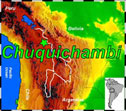|
Culture - The Altiplano
Culture across the Altiplano involves principally Aymaran people spread out across the wide-open plains.
Small, near-deserted towns dot the Altiplano, often many miles apart. Vicunas, llamas, and alpacas roam the flat plains. Occasionally, you spot Bolivians tending their sheep or llamas and can't help but wonder where they are headed or where they came from. Many times the women carry the loads, and the men, if present, will be escorting them on their bikes. Small children accompany the herds on occasion, and many times, the children themselves herd their animals across the landscape.
Living conditions across the Altiplano are some of the most extreme in the country. Homes are built from mud (adobe) and rocks and are typically no larger then a two-car garage. Most of the Altiplano is very desolate and witnessing the culture in small towns across the Altiplano is a unique experience. On our route, we met Ayamaran indigenous people in Chuquichambi, and stopped in Challapata - our one chance to purchase llama jerky.
|
Culture

Friendly Bolivians on their way home near Chuquichambi (More Culture!)
|

